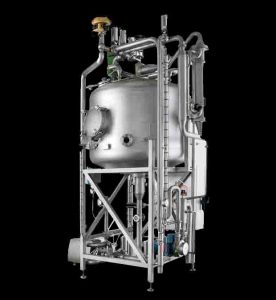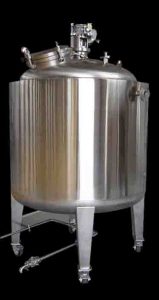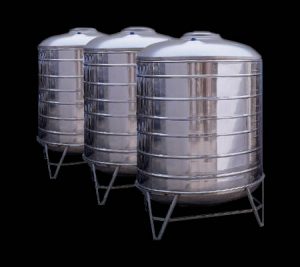Tanks USA LLC fabricates stainless steel tanks for a variety of industries such as food and beverage, dairy, beer, wine, and spirits, farming, cosmetics, pharmaceutical, chemical, and more. We provide custom designs according to our clients’ specifications using the highest quality materials at an affordable price. We also offer stainless steel pumps, valves, and parts.

Stainless steel tanks have many advantages:
1. Corrosion Resistance
Stainless steel is corrosion resistant because it exhibits natural passivation. This means that over time, a passive layer develops on the surface to protect the subsequent layers of the metal. The passive layer formed is a thin film of chromium oxide. Stainless steel usually contains 10.5% chromium or more by weight. Chromium quickly forms a passive oxide layer when exposed to air. The addition of other metals to the alloy such as nickel, nitrogen, manganese, and molybdenum can also enhance corrosion resistance. In some cases, manufacturers opt to induce the formation of the passive film using citric acid, especially in brewery, winery, and distillery tanks where the presence of iron in the metal surface can affect the taste of the alcoholic beverages.

2. High Strength
Stainless steel tanks are harder and stronger than plastics. This means they have a smaller chance of bursting at high operating pressures. The determining factor of the strength of stainless steel is the amount of carbon in the alloy. Alloys with a higher carbon to iron ratio are stronger. The presence of nickel in the alloy also increases its strength, as well as its ductility and toughness. Additionally, nitrogen and manganese improve the yield strength or the amount of force required to deform the metal. These added metals make the alloy suitable for use as pressure vessels, reactors, and holding tanks in industrial chemical processing.
3. Thermal Stability
Stainless steel offers excellent resistance to a wide range of temperatures. It can withstand extremely high temperatures and very low temperatures, making it ideal for cryogenic applications. It also remains unaffected when exposed to harmful radiation. Because of this, it is not prone to wear and tear or eventual cracking. Manganese, nickel, and molybdenum provide the ability of stainless steel to endure higher temperatures while maintaining mechanical properties such as ductility and toughness.
4. Hygienic Material
The ability of stainless steel to form a passive film makes it a hygienic material. The non-porous surface of stainless steel tanks eliminates their susceptibility to microbial contamination and leakage. This makes them more desirable for water storage than concrete tanks and appropriate for food and beverage, medical, and pharmaceutical processing plants.

5. Mobility
Stainless steel tanks can be moved from one location to another whenever needed. They are not fixed to a location like concrete tanks for water storage. Furthermore, they are durable and considerably lightweight. When it’s time for expansion, relocation of stainless steel tanks can be done with less stress and effort.
6. Recyclablity
Stainless steel tanks are environmentally friendly. Nowadays, stainless steel is composed of 50% to 80% recycled material. Scrap stainless retains its integrity during storage and remains a valuable raw material.
With these benefits, stainless steel tanks outperform other materials by a longshot. Varying the components of the stainless steel can produce different grades with exceptional durability and corrosion resistance suitable for varied applications. Because of this, stainless steel tanks can be expensive, but they are worth the investment as low maintenance and a long life cycle makes up for upfront costs.
Visit the Tanks USA LLC website to learn more about stainless steel tanks for your specific needs. For further inquiries, contact us!
https://www.iqsdirectory.com/articles/stainless-steel-tank.html

Thanks for explaining the advantages of using stainless steel. It is good to know that steel has high strength. I think it would be essential to get the steel from a reliable supplier.